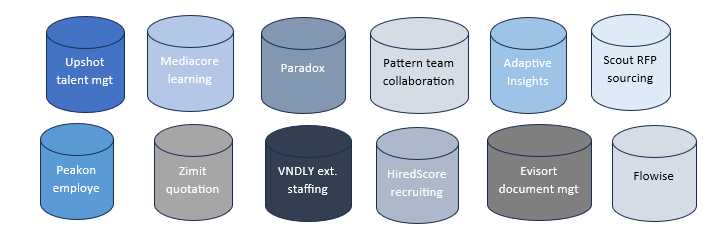ERP solutions have traditionally been defined by a unified suite of core business applications running on a shared data model, which drives operational efficiency, consistent reporting, and streamlined processes[1]. Workday, often marketed as a next-generation suite, diverges significantly from this model. Its architecture consists of disparate applications with separate data models, raising questions about its viability as a full ERP system.
Functionally, Workday lacks essential ERP capabilities such as distribution, manufacturing, supply chain management (including transportation and warehouse management), IoT, maintenance, order management, product lifecycle management (PLM), most functions of configure-price-quote (CPQ), and risk management[2].
Unlike established ERP vendors like Oracle, Workday does not rely on a singular data model underpinning all modules. Instead, its applications operate on isolated data frameworks. This creates data silos, complicates integration, and hinders end-to-end process automation as well as AI[3].
Industry critiques highlight how Workday’s siloed approach increases complexity for customers needing cross-functional processes (e.g., linking workforce planning with financial budgeting or procurement with payroll)[4]. These silos lead to inconsistent enterprise-wide reporting and analytics, undermining the “single source of truth” principle[5,6,7]. Workday attempts to address this by consolidating data into Prism Analytics, effectively an external data warehouse, rather than solving the architectural fragmentation[8].
Moreover, Workday’s numerous acquisitions add further process and data model inconsistencies, preventing truly seamless end-to-end workflows[9]. Processes spanning multiple areas—such as recruiting to payroll or order-to-cash to financial close—often require manual handoffs or complex workflow integration[10], impairing efficiency and increasing error risk. This fragmentation also complicates compliance, as audit trails and governance are dispersed across systems.
This architectural fragmentation poses significant challenges for AI adoption:
- Data Incompleteness: AI depends on unified, high-quality data. Fragmented systems yield inconsistent and delayed data, reducing AI’s effectiveness.
- Automation Complexity: AI-driven automation struggles with irregular workflows requiring manual intervention.
- Predictive Limitations: Disconnected audit trails hamper AI’s ability to trace cause-effect and predict risks.
- Compliance Risks: Fragmented controls reduce AI’s oversight capabilities for regulatory and fraud detection.

Workday’s many data stores. Having many data stores with Workday means:
- Multiple data models and data conversions from one store to another[11]
- Multiple security records
- The need to put all data from the Workday data stores into Workday Prism Analytics (AKA Data Hub) and normalize it
- Making sure that all the master data and transactional data remains in sync
- Complexities with integration, having to integrate to multiple data stores
- Issues and complexities for developers and system integrators
- Ultimately, the complexities can result in higher TCO. Lack of unified workflows and data consistency impedes agility rather than enabling it.
Beyond lacking a full ERP solution, Workday also misses critical functionalities such as CRM and manufacturing or supply chain planning. Given that nearly all organizations require integrated customer management, Workday’s absence of native CRM forces reliance on separate third-party platforms. This approach inevitably creates data silos, functional gaps, and fragmented business processes, undermining operational consistency and efficiency.
There are arguments that one could use to explain Workday’s strategy:
- “It doesn’t matter that Workday doesn’t have ERP, because your company doesn’t need the missing functionality”
- “Your company wants to use cloud solutions from multiple vendors as a premeditated strategy to make sure you’re not dependent on one vendor”
- “Your company prefers to combine solutions from multiple providers that fit your business needs best”
But in all three cases, you’d have to ask yourself ten questions:
- Are you sure this will remain the case? It could be that one day you’ll need ERP functionality that Workday doesn’t provide. Do you consider change in your business to be a risk or an opportunity?
- Perhaps you are depending on partners (for example) to manufacture products for you, and your company merely designs and markets the product. But from a continuity and recovery point of view, will that stay the same, even in times of significant supply chain upheaval?
- How stable are all these software vendors? Are you sure that the risks associated with relying on multiple vendors doesn’t somehow become bigger than the risk of relying on a single, larger, and more complete vendor?
- How well can you measure your business if you are relying on multiple vendors? Are you sure your employees are productive, your speed to market is adequate, your operational efficiency is as good as can be? Can you fully engage with your customers and business partners online? Is it possible that two people buy the same goods from the same supplier for different prices without realizing it?
- Are you as innovative as you need to be in your sector? Are your teams empowered with the right tools, or do they spend more time trying to connect the dots—the disparate data from various application vendors?
- Are you having trouble finding the best talent? Could it be that today’s dynamic work force requires more modern, consistent tools and techniques to do their jobs? Do they prefer to use a smart device and a digital assistant? Can they work with multiple systems from different enterprise application vendors?
- Can you build extensions to your environment with a single tool in a consistent manner, using the same data model, process model, and security model?
- Is the security consistent, not only across your applications, but also at every layer in the technology stack?
- Are you sure that data governance is consistent across your applications? Can you commit to GDPR, CCPA, FedRAMP?
- Running your business across multiple platforms and vendors: Are you confident this approach delivers the full potential of AI? While AI is inherently powerful, feeding it fragmented and potentially conflicting data sources undermines its effectiveness and limits its ability to generate truly intelligent insights.
Chances are that you will answer “no” to a few of these questions. The potential issues described here are directly attributable to the fact that Workday is incomplete and inconsistent with its multiple data stores.
In comparison, Oracle has a complete suite of ERP applications and a consistent cloud platform, running on the Oracle database.
Oracle built a completely, brand new set of business capabilities for the cloud from the ground up, using a single data model for all line-of-business challenges. It is modular and composable by design but engineered to work together for seamless extension.
Companies need to move toward a portfolio that is more adaptable to business change, with composable applications that can be assembled, reassembled, and extended. This is more important than the notion of suite vs. best-of-breed. Oracle can provide these composable applications because we have the entire suite of applications: ERP, EPM, CRM, HCM, and SCM. Many cloud providers started with one of those—like Workday with HCM, or SalesForce with CRM, and SAP with HCM (with the acquisition of SuccessFactors)—but with just one or two of these cloud solutions, they can’t offer the composition capabilities that Oracle can.
Oracle can offer a SaaS-based, business-centric application to complement any customer’s on-premises footprint. It adds immediate value, and we can seamlessly extend this partnership over time. With Oracle you have the possibility to compose this all into one cohesive suite, engineered to work together. No other vendor can do this right now. For a more detailed comparison between Oracle Cloud ERP and Workday, see https://www.oracle.com/erp/oracle-vs-workday/.
[1] https://www.investopedia.com/terms/e/erp.asp
[2] Workday versus a traditional ERP (April 2025), [Workday] “lacks the extensive supply chain and manufacturing tools, customer relationship management (CRM) capabilities and broader logistics functionality (like inventory management and production planning) found in traditional ERPs.” https://www.armanino.com/articles/workday-ultimate-guide
[3] “Reimagining Enterprise Productivity with Workday Illuminate: A Framework for Generative AI Adoption Across HCM and Finance” (Feb 2025). “Prism Analytics: Extends the data core to incorporate external data sources while maintaining governance and security.”
[4] “Why your employees no longer love Workday and what you can do about it” (2023): “Many enterprises today have HR Technology stacked on top of one another like a wobbling Jenga stack, cobbled together with fragile integrations and a disjointed and siloed user experience.” https://www.applaudhr.com/blog/employee-experience/why-your-employees-no-longer-love-workday.
[5] “Workday Prism Analytics: Use Cases for Technology and Software” (no publication date): “That’s not always easy in a complex data architecture with various legacy data stores and multiple systems for operations, HCM, financial management, and middle office functions. Not to mention the huge volumes of data in inconsistent formats and varying levels of transaction detail” https://www.workday.com/content/dam/web/en-us/documents/datasheets/ucb-enus-tcm-ucb-prism-use-case-brief-for-technology-software-202005.pdf
[6] “What are the advantages and disadvantages of data warehousing ?” (June 2024): “Disadvantages include high cost, complexity, data latency, scalability issues, risk of data breaches, integration issues, over-reliance on warehouse data, technical complexities, and change management”. https://global.trocco.io/blogs/what-are-the-advantages-and-disadvantages-of-data-warehousing
[7] Workday Prism Analytics (no date): “Govern disparate data sources and provide decision-makers with one source of truth” https://www.workday.com/content/dam/web/uk/documents/datasheets/datasheet-workday-prism-analytics.pdf
[8] Data from any source. Directly in your flow of work. (no date): “HR and finance often require data beyond Workday for better decision-making and planning. With Workday Prism Analytics, IT teams can securely integrate and deliver that data across our AI platform—seamlessly embedding insights into the flow of work.”
[9] Comprehensive Guide to Workday Integration: Challenges, Benefits, and Steps (May 2025): “Example impact: Data inconsistencies, broken workflows, and manual workarounds.” https://www.putitforward.com/guide-to-workday-integration
[10] Workday has separate data models for example for Adaptive Planning, https://www.workday.com/content/dam/web/en-us/documents/datasheets/enus-pln-da-workday-adaptive-planning-integration.pdf and VNDLY https://www.workday.com/content/dam/web/en-us/documents/datasheets/workday-vndly-datasheet-vms.pdf and Peakon https://www.workday.com/content/dam/web/en-us/documents/datasheets/workday-peakon-employee-voice-integration-datasheet-enus.pdf
[11] https://www.workday.com/content/dam/web/en-us/documents/datasheets/workday-peakon-employee-voice-integration-datasheet-enus.pdf shows that Workday Peakon for Employee Voice requires integration with Workday HCM. This proves that Workday is not a suite with one data model. The report “The Workday Economy – As AI Disrupts, A New Strategy Emerges” (June 2025) describes how Workday is evolving to a partner-driven ecosystem, which means partner solutions have their own data model and thus need integration with Workday core HCM and Financials https://joshbersin.com/2025/06/the-workday-economy-a-bold-new-strategy-emerges/
